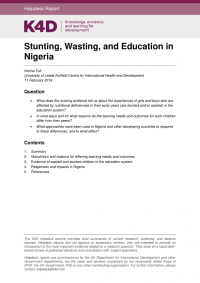Africa/ Nigeria/ 19.03.2019/ Source: reliefweb.int.
Summary
Globally, the number of primary school children with nutritional deficiencies is high. This rapid review focuses on children with such deficiencies (namely stunting and wasting), and how it affects them throughout their primary education. Although the focus is on Nigeria, other country examples and their approaches to address this issue are also included, where available.
Key points are:
- As hungry children find it difficult to concentrate (Muiru et al., 2014; Foodbank, 2015;
Businge, 2016), their learning needs and outcomes are different to well-nourished children. - Countries respond to these children in different ways: the most popular being school feeding programmes, e.g. in India, which has a high prevalence of stunting and wasting, there is the free Midday Meal Scheme, which is the largest such scheme in the world (Singh et al., 2012).
- However, such approaches have varying impacts: positive effects on measured learning were found in Burkina Faso and Peru (World Bank Group, 2018). However, in Kenya, providing school meals took significant time away from the classroom, and so they had an ambiguous net effect (World Bank Group, 2018). Therefore, it is worth noting that although school feeding gets children to school, it does not always improve learning (FAO et al., 2018).
- Differences were found between urban and rural areas: in Nigeria, children from rural areas are almost twice as likely to be stunted as children from urban areas.
- In Nigeria, as part of a public private partnership, Bridge school teachers use an innovative programme designed to scale up effective new approaches to education.
However, no evidence is available on successful approaches to teaching malnourished children, e.g. how the timetable is organised, what practices are used in the classroom, what resources are used, etc. - Read-Aloud (RA) story lessons in reading and maths learning outcomes in northern Nigeria were evaluated by Moussa et al. (2018). The Reading and Numeracy Activity (RANA) Programme provides training, monitoring, and support to help teachers properly use these materials in class. Maths RA lessons were relatively more effective than the language RAs in improving listening comprehension, missing number identification, and maths word problem scores- however these results are for low socio-economic status pupils, not necessarily malnourished ones.
- Preliminary findings of the school-based component of Young Lives research found a relationship between teacher qualifications and experience, and pupil’s maths scores (Woldehanna et al., 2017).
- In the classroom, large numbers of over-age malnourished pupils present a challenge for teachers, who must teach a more diverse group with lower levels of maturity and school preparedness.
- Teaching malnourished children does not seem to feature in the curricula of teacher training programmes (Drury, 2102; Rampal & Mander, 2013). In 2018, the Nigerian Federal Government revealed plans to revamp the country’s basic education sector – however there is no detail regarding specific approaches to teaching malnourished children
- The available evidence suggests the need for teacher training to be relevant to classroom reality, to maximise the chance of teachers adopting new techniques in the classroom, and to be linked to better management of teachers at the school level to maximise time on task (Vogel and Stephenson, 2012).
- Chinyoka (2014) recommends that teachers adapt their behaviour to motivate the learners to work and co-operate with peers. This teaching methodology is supported by Snowman and Biehler (2011).
- In South Africa, the First National Bank Fund Primary Education Programme (PEP) aims to train teachers to identify pupils affected by malnutrition, as well as assisting them in what they can do to help these learners. The end-term evaluation recommends that the programme clearly had a positive impact in most objective areas (Khulisa Management Services & Bisgard, 2017).
The main sources of evidence used for the rapid review were taken from peer reviewed journals, as well as grey literature and investigative projects. In general, nutrition status of primary schoolchildren in Africa has received relatively little attention in comparison to that of younger children (Saltzman et al., 2016). Most of the data available focuses on the causes of malnutrition, and the effect of adapting diet to improve education. There is little empirical evidence on the effect of childhood malnutrition on children’s cognitive achievements in low-income countries (Woldehanna et al., 2017). There are limited teaching approaches specifically used in Nigeria.
The evidence found was ‘gender-blind,’ as there is very little information available exploring the experiences of girls and boys who are affected by nutritional deficiencies in the early education system. Children with physical disabilities were not a focus of this rapid review.
Link of the document: https://reliefweb.int/sites/reliefweb.int/files/resources/540_Stunting_Wasting_and_Education_in_Nigeria.pdf
Source of the notice: https://reliefweb.int/report/nigeria/helpdesk-report-k4d-stunting-wasting-and-education-nigeria






 Users Today : 27
Users Today : 27 Total Users : 35403365
Total Users : 35403365 Views Today : 31
Views Today : 31 Total views : 3332657
Total views : 3332657